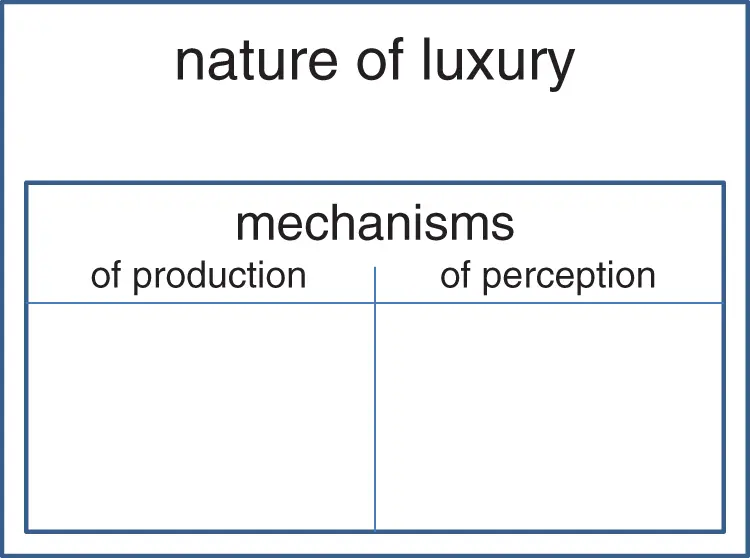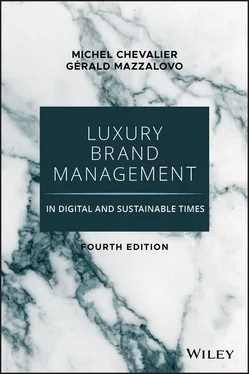
Figure 1.1 Analytical Scheme of the Definitions of Luxury
On the one hand, we therefore find definitions relating to the production of luxury; on the other, definitions relating to its perception (see Figure 1.1). Alternatively, in economic terms we could identify them as the supply and the usefulness logics.
Sociologists and psychologists are naturally interested in the resonance of luxury in the population—and are, therefore, on the side of the mechanisms of perception.
For some authors, such as Pierre Bourdieu, buying a luxury brand is a way to express a social position: according to him, luxury is essentially defined by its dimension of social communication. 8The American economist Thorstein Veblen and his concept of “conspicuous waste” also belongs in this group. 9According to him, highlighting one's consumption of pricey products is a method of building respectability for the man of leisure. Jean Baudrillard has a similar approach: for him, our objects, torn between their value of use and exchange value “are taken in the fundamental compromise to have to mean, that is to give a social sense.” 10In the same vein, Gilles Lipovetsky recently wrote: “Luxury is seen as perpetuating a form of mythical thinking at the heart of a desacralized commercial culture.” 11In other words, in a society where everything is measured and bought, luxury would reintroduce an almost magical, not strictly quantitative distinction among individuals.
Economists who have reflected upon the phenomenon of luxury are especially attached to integrating the question of its valorization into a global macroeconomic model. They are therefore positioned also on the side of the mechanisms of perception. For instance, the theory on the elasticity of demand for luxury goods is considered to be positive and greater than 1, which means that the demand, paradoxically, will increase when the price increases. This is obviously the symbolic value of the luxury product—its distinctive effect—that is the cause.
For this other category, the discourses oriented toward the mechanisms of the production of luxury are made by operational managers, executives concerned with the functioning of their brand and the conditions of production of “the luxury effect.” They also need definitions, but more pragmatic ones.
Consider the case of Patrizio Bertelli, president of Prada: he defines luxury by a convergence of creation and intuition. Another example is the Comité Colbert, an association regrouping 82 French luxury houses in 2020 (plus 16 associated members and 6 European members), which stresses the alliance between tradition and modernity, know-how and creation, international reputation and culture of excellence.
For these approaches, what defines luxury is less its social implications than a set of qualifications embedded in the production of the object or service: quality of materials, technical know-how, and bold and creative talent, whose sustainability is ensured by the transmission of intangible values—tradition, artisanal exigency, quest for perfection.
The great fashion designer Coco Chanel used to define luxury simply as the opposite of vulgarity: a way to evade the question, which refers more to the mechanisms of perception, but which shows us a contrario how the discourses of the actors of the luxury world have become more profound in the postmodern world.
We can already hold on to two universes of clearly distinct representations, whose issues diverge and even conflict. But it is possible to refine this classification further.
Social and Individual Aspects
For psychologists and sociologists focused on the perceptions of luxury, the interest is first on the paradoxical commitment to some object, apparently useless: What are the hidden reasons behind luxury consumption?
The perceptual approach reveals two types of motivations that do not overlap entirely: one can consume luxury (possibly unconsciously) in order to display it or, in a more personal approach, simply to have fun for his own pleasure. This dimension seems often neglected by the sociological discourse but cannot be reduced to the previous one. This is a more private dimension, a dimension of comfort and individual hedonism, as points out, for example, Jean-Paul Sartre in L'Être et le Néant (1943), when he wrote: “the luxury does not designate a quality of the object owned, but a quality of possession.”
It is conceivable, for example, that I buy a luxury soap “because I'm worth it” to identify with the celebrity who makes the claim—in short, for the sake of social representation. But I also buy it because it smells good and its foam is smoother than soap from other brands. These qualities I do not need to show to anyone in order to enjoy them. The soap serves my own hedonism: it pleases me, and if I am no longer convinced that it smells better than the others, I will probably stop buying it, despite the prestige of its brand.
Still, the pleasure born from the consumption of luxury comes also from stories that can be told. Luxury makes us dream and we also can dream alone. How do I know whether my soap feels objectively better or if it is the brand advertising, the reference to a celebrity that convinced me? In this sense, social representation is never far from personal experience. This is what Jean Baudrillard stresses when writing “the private and the social are mutually exclusive only in the daily imagination.” 12
Without denying this analysis, one wonders if there is not, among sociologists of luxury, a certain moralist bias that encourages them to ignore the question of hedonism. In their discipline, social experience often overwhelms pure pleasure—or, said differently, the intrinsic qualities of the product. These qualities remain, consumers will agree, constitutive of experience.
The Brand and Its Manifestations
As we just mentioned, discourses about the mechanisms of production of luxury characterize the point of view of operational executives. They are, however, structured by the phenomenon of the brand. It introduced a second and critical dimension in a productive approach to luxury. The brand generates issues that the manager cannot confuse with those of the product itself.
For example, specific qualities are expected from a Hermès scarf, the results of a know-how that can be recognized visually and tactilely and that are the indispensable and defining attributes of Hermès scarves. However, something else is expected: a more intangible supplement, an idea, a prestige that will be called “Hermès”—as a brand or, more precisely, as a brand identity.
There is a sort of “beyond the actual product,” that is the brand and that the product must promote without betrayal. But the product is only one of the possible brand manifestations, making brand management issues even more complex. Advertising, points of sale, store windows, websites, social networks, sponsorships, and so forth are other forms of brand manifestations and not less essential for the promotion of its identity.
Two dimensions of brand identity are usually distinguished: the brand ethics, the intelligible part that is made up of its values, its vision of the world, and its idealized representation; and the brand aesthetics, the sensory part that affects its physical and concrete manifestations or all imaginable interfaces between the brand and its consumers. The aesthetic treatments of the sensory part of the brand participate in the sensitive experience of the brand. The emergence of “lifestyle brands” tells us that this experience spread beyond products, in other areas, such as communication, spaces, or behaviors (see Chapter 8on creation).
Читать дальше













